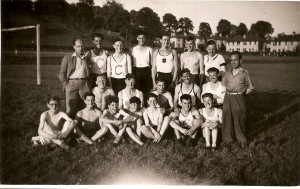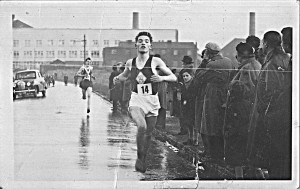John Morgan standing on the right.
Johnny Morgan, who joined Clydesdale Harriers in season 1936/37, was always easy to recognise because of his very small stature. He maybe had to look up to Harry Fenion. However his contribution was immense at a time when many such as Andy McMillan, James P Shields and David Bowman were also making big contributions. John was one of the most respected men in the club when I signed up in 1957. Like so many good club men of whatever outfit, he did some running but his main contribution to the club was as an official, an organiser and a coach – he was also the recognised club starter. The club records for the period 1936 – 1939 have him turning out in only six races. In October 1936 he was eleventh of eleven in the club Novice Championships, in October 1937 it was the same position (11th of 11), December 1937 he was twenty fourth of twenty four in the 5 Miles Handicap, on 25th December 1937 he was sixteenth of thirty in the Christmas Handicap, a year later he was fourteenth of 21 in the Christmas Handicap and in February 1939 he was sixteenth of twenty in the Seven Mile Handicap. After the war started he was tenth of fourteen in the 1940 Christmas Handicap and that was his last race until he went into the Army in 1942. What he was to do for the club and for athletics generally after the War cannot be over-estimated.
John was club secretary from 1939/40 to 1942/43 and 1946/47 to 1950/51. The two spells in office were broken by his war time service in the Army. John served in Burma with the Chindits so must have seen a lot of the action. The Chindits were the Indian Division of the British Army in World War II and carried out guerrilla warfare on the Japanese in Burma (now Myanmar) under the command Brigadier General Orde Wingate. The name came from the mythical beast half lion/half eagle that was placed at the entrance to Burmese temples to scare away evil spirits. He also contracted malaria there and as is the case with the disease suffered off and on afterwards from recurrences. Many other local athletes also served in the Far East: one of these was Alex Kidd a member of Garscube Harriers and well known and respected throughout Scotland. He also came home suffering from malaria and although they made light of it, the disease had to be respected and showed itself from time to time. After one race on a particularly bad day at the Woodilee Mental Asylum (as it was called at that time) in Lenzie, the Changing Room became flooded because of a burst pipe. Alex was lying on a bench shivering and shaking and as the others all scrambled out with their clothes and gear leaving him there, he was saying, “it’s all right – it’s just the malaria!”
Although John joined the club as a runner he ran mainly in pack runs and inter club fixtures with no major trophies to his name. His racing record has already been detailed. His running after the War was seriously affected by the malaria but he used to turn out every now and then with Andy McMillan, James P Shields, Dan McDonald and Jim Murphy just for a run. In my time in the club he was best known as the official club starter and kept the two guns and ammunition at his house. He was an ever present at club fixtures and championships whether track, road or cross country
His big contribution to the club and to the sport was as an administrator and official. He attended a few committee meetings in the 1930’s before he was elected as club secretary a mere three years after joining the club. This was not simply because no one else was capable of doing the job or wanted to do the job – it was because he was recognised as being a good administrator. Came the war and he was elected as secretary to the war time committee whose job was to keep the club in good order until the cessation of hostilities. He worked well in the job and only left the committee when his Army Service took him off to Burma. This service left him as already noted with malaria and he had to take quinine for the rest of his life. One story is that when he said he would have to go home to have some quinine, the others remarked that he meant “Queen Anne” which was a type of whisky.
As soon as he was back home, it was not long before he was back on to the committee and his second spell in the hot seat was possibly his best. The club race results book opens a new page with the following:
SEASON 1946-47
In which it is hoped to carry out our full
Pre-war runs programme.
(John Morgan, Secy)
He was not only on the club committee but he was a member of the County Association and served on the Committee of the SAAA – the governing body of the sport in Scotland. He not only sat on the Committee of the Dunbartonshire AAA’s but was one of the pioneers of the organisation and the club representative in the setting up of the association. In addition to his committee work he did a lot of coaching and was the club’s official starter. He had two guns of his own and the ammunition was supplied by the club. The part he played in the organisation of the Clydesdale Harriers Youth Ballot Team Race when it started up in 1947 was such that the trophy awarded to the winner was named the Johnny Morgan Trophy and it is still in the club’s possession. The picture below is of Eddie Sinclair winning the Johnny Morgan Trophy.
At that time he was always very helpful to the younger committee members and Alex Hylan said that he would come before the meetings and ask if he, in whatever capacity, needed any help in preparing for meetings. John also donated the Zetland Trophy for the Ladies Track Championship and named it after the Zetland Estate where his parents worked – the earldom of Zetland was created in 1838 for Laurence Dundas (of Port Dundas fame).
In the mid 1950’s the club had a quite superb Ladies Section with many first class athletes including not only Scottish but also British champions and international athletes. The section was led by Jean Struthers and John was the main coach. Then in the late 1950’s Tom and May Williamson formed a new club to be called Western AAC and it would be based at Kirklee in Glasgow. They attracted girls from all clubs and the effect on several clubs in Glasgow (Springburn Harriers Ladies, Bellahouston Harriers Ladies and Clydesdale for instance) was devastating. When one of the best runners in Bellahouston Harriers joined up with Western, she was asked by her regular training partners in Maryhill Harriers Ladies why she had not joined them if she was leaving Bellahouston. Her reply was that they had never asked her! Virtually all the Clydesdale Ladies left en bloc to join this attempt to form a ‘club of champions’. These outfits keep appearing – Sans Unkles’ and Dunky Wright’s Caledonia AC, the Robson brothers and their Edinburgh/Reebok/Leslie Deans/Mizuno Racing Club and so on – and seldom last long. The damage inflicted on other clubs is at times considerable. John Morgan was so upset that he gave up coaching on the spot and another coach had to be found. He stayed to work for the club at Committee level and as starter and timekeeper at club and county races.
Runner, committee man, coach, official club starter – and one of the first class group of men who kept the club functioning after the war. When he died in November 1967 the ‘Clydebank Press’ said: It is with deep regret that I have to announce the death of Mr John Morgan one of our older members. Johnny as he was known to young and old alike served the club well in many official positions since the War and although he was dogged by illness in recent years he still turned out as an official SAAA starter when needed. His services were not limited to Harriers activities as he was well known for the help he gave to local schools and Youth organisations and often at considerable expense to himself. We in the club will miss Johnny greatly and extend our deepest sympathy to his family.”

